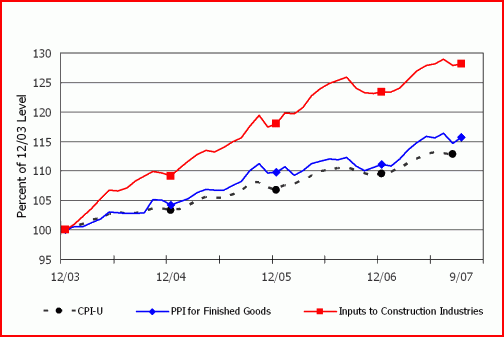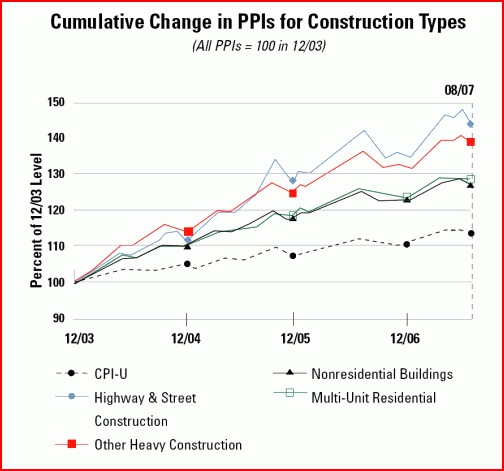Construction Inflation Higher Than CPI
 Ever wonder about rising construction costs and why it's so absurd to expect spending on infrastructure to stay within the limits of consumer inflation (CPI) while keeping up with growth?
Ever wonder about rising construction costs and why it's so absurd to expect spending on infrastructure to stay within the limits of consumer inflation (CPI) while keeping up with growth?
After years of minimal cost increases, prices of many construction materials skyrocketed from 2004 to mid-2006. Since mid-2006, some input prices have moderated, while others have fallen. But the cumulative increase in the producer price index (PPI) for construction inputs since December 2003 (28 percent through August 2007) remains more than double the 13 percent increase in the most common measure of overall inflation, the consumer price index (CPI) for all urban consumers. Labor costs, in contrast, have risen at similar rates for construction and for the private sector as a whole.Cumulative Change in Consumer, Producer & Construction Prices

Source: Associated General Contractors of America, Data Digest.
The cumulative difference matters because the estimates for many projects now being bid, especially public facilities, were prepared in 2003-2005 under the assumption that construction costs would escalate at the same rate as the CPI. That divergence explains why some projects are being canceled, delayed or redesigned.
In the next several months, the PPI for construction inputs, which covers items used up in construction such as diesel fuel as well as materials that go into a project, is expected to accelerate to a 3-5 percent annual rate of increase from the recent 1.5- 3 percent range. By the end of 2008, and indefinitely thereafter, construction input costs are likely to be rising at 6-8 percent. Labor cost increases could top 5 percent by the end of 2007 and 5-6 percent in subsequent years.

For more information read the AGC Construction Inflation Alert
The bottom line: Owners, budget setters and contractors should expect larger materials and labor cost increases in 2008 than they have experienced in the past 12 months. Nonresidential construction activity is still likely to grow, as will demand for construction materials that are used in other industries and other countries.











2 comments:
I wonder if labor costs will continue to rise in the wake of the slowdown in residential construction activity. It's certainly possible that the input costs will keep on rising though, with demand from China and other fast growing countries driving up prices.
The AGC reports credit the residential construction slowdown with some reduction in labor costs in certain specialized trades but there is a limit to the number of workers who can make the switch. Non-residential construction is different work. Some residential workers are not accustomed to it or skilled enough for the switch. There are also many specialized trades that exist primarily in non-residential construction for which the labor pool is shrinking and for which labor costs continue to rise.
Post a Comment